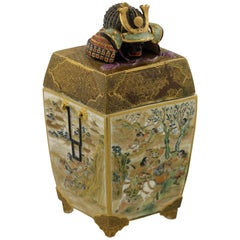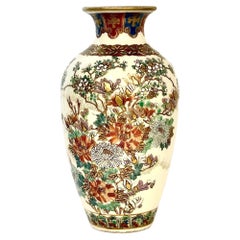Satsuma Antiquities
1
to
1
1
1
1
1
1
19
10
4
4
3
Creator: Satsuma
Satsuma Earthenware Vase and Cover, Japanese, Meiji Period
By Satsuma
Located in West Palm Beach, FL
A Satsuma Earthenware vase and cover,
Japanese, Meiji period, (1868-1912)
decorated in polychrome enamels and gilt over a clear, crackled glaze, delicately painted with samurai on ...
Category
1890s Antique Satsuma Antiquities
Materials
Ceramic
Related Items
Satsuma Japanese Meiji Miniature Enameled Teapot Kozon Mark
By Satsuma
Located in Bishop's Stortford, Hertfordshire
An exceptional Japanese Satsuma miniature spool shaped pottery teapot and cover finely hand enameled with Kozon mark and dating from around 1880. This delightful teapot has an invers...
Category
19th Century Japanese Meiji Antique Satsuma Antiquities
Materials
Pottery
Antique Japanese Meiji Satsuma Painted Vase
By Satsuma
Located in LA CIOTAT, FR
A petite and beautiful hand-decorated ceramic baluster vase, painted all around with traditional Japanese motifs, including native flora, birds and bamboo stems on a creamy glazed background. The colour palette is bold and bright, with highlights of green, red and blue, together with plentiful gilt relief...
Category
19th Century Japanese Meiji Antique Satsuma Antiquities
Materials
Ceramic
Meiji Period Diminutive Satsuma Baluster Vase.
By Satsuma
Located in Vero Beach, FL
Meiji Period Diminutive Satsuma Baluster Vase.
This Japanese Satsuma vase from the late Meiji period is hand painted and gilt decorated with a Japanese landscape in exquisite detail...
Category
20th Century Japanese Meiji Satsuma Antiquities
Materials
Porcelain
Japanese Satsuma Miniature Tripod Teapot and Cover, Meiji Period
Located in Delft, NL
Japanese Satsuma miniature tripod teapot and cover, Meiji period
A circular flattened form miniature teapot with cover painted in enamels and gilt...
Category
Late 19th Century Japanese Antique Satsuma Antiquities
Materials
Earthenware
Japanese Meiji Period Satsuma Large Square Bowl Centerpiece
By Satsuma
Located in Vero Beach, FL
Japanese Meiji Period Satsuma large square bowl
Antique early Meiji Period 15" square with scalloped rim Satsuma bowl. Highly unusual and finely painted. ...
Category
19th Century Japanese Meiji Antique Satsuma Antiquities
Materials
Ceramic
Antique Meiji Period Satsuma Shimazu Vases - a Pair
By Satsuma
Located in Seguin, TX
Circa 1900 pair of Satsuma vases. Hand painted coastal landscape, mountains, women and children outside of elaborate homes. Signed on the bottom with the Shimazu Clan crest, wear to...
Category
Early 20th Century Japanese Meiji Satsuma Antiquities
Materials
Ceramic
Japanese Satsuma Bowl, Meiji Period
Located in London, GB
Signed, Meiji period (late 19th century), Decorated in various coloured enamels and lavish gilt on a blue ground with panels containing samurai, ladies in kimono, the interior with a...
Category
Late 19th Century Japanese Antique Satsuma Antiquities
Materials
Porcelain
Pair of Meiji Period Satsuma Earthenware Vases
Located in Lymington, Hampshire
A pair of Meiji period Satsuma earthenware vases, each with applied elephant-mask handles, painted in overglaze pastel enamels and gilt with a continuous central frieze of sages and ...
Category
1880s Japanese Meiji Antique Satsuma Antiquities
Materials
Earthenware
Japanese Meiji Period Satsuma Tripod Censer
Located in New York, NY
Very fine quality Japanese Meiji period Satsuma tripod censer with a foo dog finial.
wonderful painting quality.
Category
Late 19th Century Japanese Meiji Antique Satsuma Antiquities
Materials
Ceramic
Satsuma earthenware vase by kinkozan, Meiji period
By Kinkozan
Located in Tel Aviv - Jaffa, IL
the body of this small marvelous vase is painted with a scene of a puppet show vendor with his wood backpack, on top of the backpack there are toys and dolls, he is surrounded with a group of 6 children, and on the background you can see a village.
on the other side of the vase there is an amazing painting of flowers and on the sides there are two amazing strong pine trees, the amorphous background is decorated in a "Tortoiseshell" color and design that gives it a real character and which is quite rare to see on satsuma pottery.
all the vase is over richly overpainted over the glaze with gold, which gives it its depth and realism.
signed Kyoto Kinkozan zo, and sealed Kinkozan zo
Kyoto’s Satsuma:
The painting technique used in Kyoto’s Satsuma-style ware is said to be the invention of the sixth generation Kinkōzan Sōbei (1824–1884). The Kinkōzan were a famous family of Kyoto Awataguchi potters who made ceramics that were used at Shōren'in, a temple closely tied to the imperial family, and by the shoguns of the Edo government. In fact the shogun is said to have granted them the name Kinkōzan. With the upheavals at the end of the Edo period, however, and the reforms of the subsequent Meiji government, the potters lost their traditional patrons and had to develop new markets.
Just at that time, the visit of a certain Westerner is said to have decided them to embark on overseas trade. By 1870, they had perfected Kyō Satsuma...
Category
1890s Japanese Meiji Antique Satsuma Antiquities
Materials
Gold
Satsuma Japanese Meiji Pair Diamond Shaped Pottery Vases
By Satsuma
Located in Bishop's Stortford, Hertfordshire
A good and unusual pair antique Japanese Satsuma Meiji diamond shaped pottery vases decorated with monk figures with a scrolling dragon dating from the 1...
Category
19th Century Japanese Meiji Antique Satsuma Antiquities
Materials
Pottery
Large Meiji Period Satsuma Earthenware Floor Vase
Located in Lymington, Hampshire
A large Meiji period Satsuma earthenware floor vase, the of baluster form, painted in pastel overglaze enamels and gilding with two large sprays of flowers including prunus blossom, ...
Category
1870s Japanese Meiji Antique Satsuma Antiquities
Materials
Enamel
Satsuma antiquities for sale on 1stDibs.
Satsuma antiquities are available for sale on 1stDibs. These distinctive items are frequently made of ceramic and are designed with extraordinary care. There are many options to choose from in our collection of Satsuma antiquities, although brown editions of this piece are particularly popular. Prices for Satsuma antiquities can differ depending upon size, time period and other attributes — on 1stDibs, these items begin at $4,500 and can go as high as $4,500, while a piece like these, on average, fetch $4,500.
Questions About Satsuma Antiquities
- What is a Japanese Satsuma vase?1 Answer1stDibs ExpertOctober 12, 2021A type of Japanese pottery originated from Satsuma province in Japan is termed as Satsuma ware. A vase of this kind is known as a Satsuma vase. An interesting fact about Satsuma ware is that they feature a "makers mark" or marking as a key to help collectors unlock the value, age and authenticity of the piece. Shop a range of antique and vintage Japanese vases on 1stDibs.
- How do I date a Satsuma vase?1 Answer1stDibs ExpertMarch 22, 2022To date a Satsuma vase, study its mark. Vases made before World War II normally feature a mark in Japanese. A vase that says "Royal Satsuma" likely dates back to the late 20th century. You'll find a variety of expertly vetted Satsuma vases on 1stDibs.
- 1stDibs ExpertApril 5, 2022Satsuma porcelain or pottery includes a maker’s mark with the name of the person who made the item. Japanese numbers may also indicate that a Satsuma piece was part of a collection. Genuine Satsuma pieces will not have a “Made in Japan” label and should only include Japanese characters. When in doubt, work with a certified appraiser to determine the authenticity of your Satsuma piece. Find a variety of expertly vetted Satsuma porcelain and pottery collectibles on 1stDibs.
- 1stDibs ExpertFebruary 1, 2024One way to tell if your Satsuma vase is valuable is to look for markings on it. The oldest and typically most expensive pieces will usually have the Shimazu family crest — a circle with a cross through it — hand-painted on the bottom. If the piece is stamped with the marking or says "Made in Japan" in the Roman alphabet, it is a newer vase. Factors like the style of the vase and its condition will also impact its price. It's a good idea to have a certified appraiser or knowledgeable dealer evaluate your vase to determine its value. Find a variety of Satsuma vases on 1stDibs.


